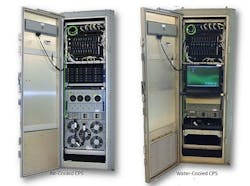GTS to provide air- and water-cooled shipboard computers for Navy cruisers and destroyers
Officials of the Naval Sea Systems Command in Washington are asking GTS to build the Common Processing System (CPS) -- a shock-resistant open-architecture computing system for Navy cruisers, destroyers, and other programs. The contract includes spare parts and engineering services.
The CPS provides a common computing infrastructure for ship combat systems, including processing and memory, data storage and extraction, and I/O interfaces for combat systems. The GTS team building the CPS consists of Northrop Grumman, DRS Technologies, IBM, and GoAhead Software, which has been acquired by Oracle Corp. in Redwood City, Calif.
GTS engineers will build the CPS using commercial off-the-shelf (COTS) hardware and software such as BladeCenter technology that supplies common infrastructure for processing and network fabric. Plug-in components are accessible, hot-swappable, and battle-ready protected by the GTS Advanced COTS Enclosure (ACE).
Related: Navy searches for small business to manufacture shipboard Common Processing System (CPS)
The CPS consists of a rugged enclosure and three subsystems: the processing subsystem, the storage and extraction subsystem, and the I/O subsystem.
The processing subsystem provides the computing resources to execute combat system application programs on Navy surface ships. The storage and extraction subsystem provides data storage for CPS operating system (OS) image storage, program storage, data extraction, and database management. The I/O subsystem, meanwhile, interfaces the processing and storage hardware to various external elements.
Oracle provides for the Common Processing System open-standard middleware, designated SAFfire, for the CPS to support high-availability management of mission-critical combat system. SAF stands for Standards Availability Forum, an industry consortium of companies that develop open standards-based products. The new-generation Open-SAFfire middleware uses open-source technology based on SAF standards.
The overall CPS is designed with a shock-isolating enclosure that protects unhardened COTS components from the intense shock and vibration that can occur on Navy surface ships -- including hits from missiles and torpedoes. The CPS comes in air- and water-cooled versions.
The CPS originally was designed to support upgrades to the Aegis weapon systems aboard Navy Ticonderoga-class cruisers and Arleigh Burke-class destroyers, but has been expanded to other Navy vessels. Navy officials last summer had solicited industry offers for the build-to-print production of the CPS, and ultimately chose GTS, the original manufacturer.
The contract awarded this week will provide for production, testing, and delivery of air- and water-cooled CPS computers. GTS will do the work in Virginia Beach, Va., and should be finished by May 2018.
For more information contact Global Technical Systems online at www.gtshq.com, or Naval Sea Systems Command at www.navy.mil/local/navsea.
